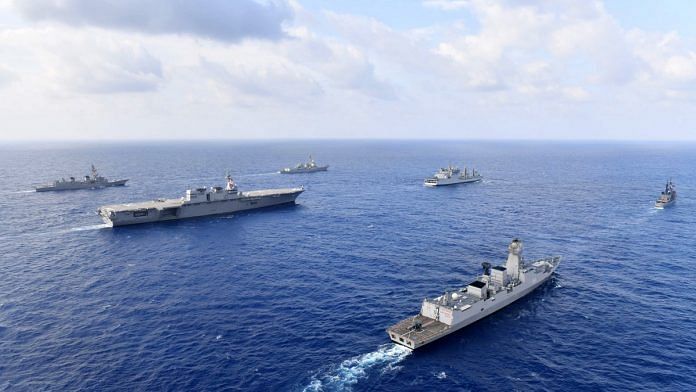In early November, the OTT platform Netflix removed two episodes from the Australian spy drama series Pine Gap following complaints from the Philippines and Vietnam. The reason behind Manila and Hanoi’s objection was the use of maps of the South China Sea by the series, which showed the nine-dash line. The nine-dash line depicts China’s claimed maritime territory in the South China Sea, which is disputed by other littorals. The line forms the crux of an issue, which, despite being decades old, has assumed significant prominence in recent years due to Beijing’s overtures in and across the sea space.
The Modus Operandi of Maps and Messaging
Maps are an essential instrument of establishing sovereign territorial delimitation and China is no stranger to utilising maps for the exertion of the same. Maps also comprise a critical component in the country’s “three warfares”—public opinion warfare, psychological warfare, and legal warfare, all three of which are systematically deployed in the South China Sea. Since the 1950s approximately, Beijing has used various cultural products to further its maritime territorial claims with Pine Gap becoming the latest victim.
Earlier in 2020, a video game called “Little Panda’s World Adventure,” produced by the Zhi Yong Information Technology based in China, was removed from Google Play Store and the Apple App store; and in 2019, the movie Abominable, a joint production by DreamWorks animation and Shanghai-based Pearl Studio, was pulled from theatres—both for having shown the South China Sea with the nine-dash line. Likewise, in August 2020, another Netflix show—Put Your Head on My Shoulder—was censured after depicting similar maps of the Sea. Around roughly the same time, reports surfaced about textbooks in Australia, which were found to be reiterating Chinese Communist party propaganda, including the disputed South China Sea map resulting in the unsold books being rescinded. In April 2021, the Swedish fashion retailer H&M faced a robust Twitter backlash after using the same map on its website for promotions in Shanghai.
While political references in popular culture may not apparently have any significant bearing, they do perform the subtle yet persistent task of endorsement and, thereby, perpetuation of unlawful claims. In the recent Netflix instance and the ones cited above, China’s wrongful claim over most of the South China Sea serves as confirmation and legitimisation of Beijing’s position, which is in flagrant contravention of international maritime law. Such references in popular culture and fashion, thus, seek to subvert public knowledge and perception of reality as the PRC’s governance system relies heavily on the state’s control and manipulation of the information environment. As the Philippine films board, put it, the use of the map was “no accident as it was consciously designed and calculated to specifically convey a message that China’s nine-dash line legitimately exists.”
Also read: China believes its time has come. But here’s what it hasn’t come to terms with yet
The Necessity of International Resolve
It is striking, yet, perhaps, no longer surprising to see that Beijing’s strategies with respect to what it considers its national security do not respect international boundaries and sovereignty. In the recent past, we have seen several instances of China’s state-sponsored overreach (ex-maritime militia in the South China Sea; its coast guard law and so on). All of these very clearly demonstrate how the country is expanding the very nature of its influence across the immediate neighbourhood, the wider Indo-Pacific, and also across the Eurasian landmass via the Belt and Road Initiative (BRI). “Nature of influence” refers to the deployment of not just diplomatic or political influence, but also by according greater power and resources to the military, navy and, in this particular case, through ramped up utilisation of cyber technology.
Perhaps, more alarming is the pace and reach of Beijing’s espionage activities. China is systematically deepening its regional strategic ambitions and Southeast Asia happens to be the easiest target and the stepping stone for spreading the net beyond the neighbourhood with the South China Sea forming the immediate arena for this purpose. What countries in the Indo-Pacific and other external actors like the EU—who are getting increasingly involved in the region—need to realise is that actionable measures need to be adopted by platforms like the Quad and other trilateral platforms if China’s unrestricted footprints are to be arrested.
Strategic messaging serves to underpin, and technological advances have also added to, China’s offensive tactics in the South China Sea. While the country had been steadily expanding its physical presence on the disputed rocks, shoals, and reefs that dot the Sea for several years now with the construction of warehouses and defence facilities, fresh reports point to the ramping up of electronic and communications warfare capabilities in the region as well. For instance, Mumian, on Hainan Island, has been equipped with facilities that can track and counter foreign vessels with greater accuracy with the help of satellite tracking and communication (SATCOM) and communications intelligence (COMINT) platforms. Another report shows how China’s cyber espionage is targeting both governments as well as private sector organisations across Southeast Asia. Electronic and cyber espionage, together with the coast guard law introduced in 2020 and the deployment of the country’s maritime militia, comprise gears in the ever-expanding toolbox for furthering strategic influence and exerting political control.
Pratnashree Basu is an Associate Fellow at Observer Research Foundation, Kolkata, with the Strategic Studies and Maritime Initiative. She is a 2017 US Department of State IVLP Fellow and is currently pursuing her Ph.D in International Relations at Jadavpur University. Views are personal.
This article was first published by Observer Research Foundation and has been republished here with permission.



